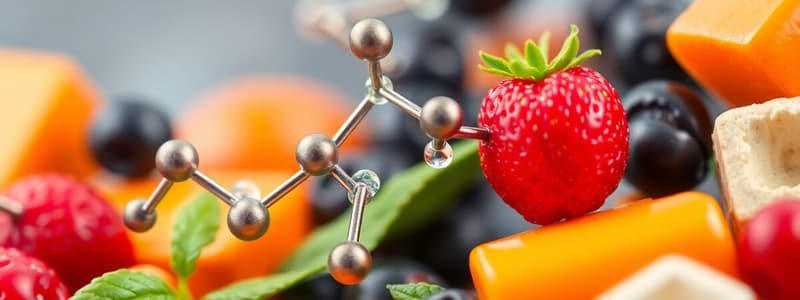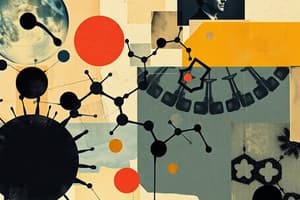Podcast
Questions and Answers
What is the primary function of vitamins in the body?
What is the primary function of vitamins in the body?
- They serve as building blocks for cellular structures.
- They act as energy sources.
- They are essential for metabolic functions. (correct)
- They produce hormones.
Vitamins A, D, E, and K are classified as water soluble vitamins.
Vitamins A, D, E, and K are classified as water soluble vitamins.
False (B)
Name one deficiency state that can arise from a lack of vitamins.
Name one deficiency state that can arise from a lack of vitamins.
Beriberi
Vitamins are classified into two classes: fat soluble vitamins and __________ vitamins.
Vitamins are classified into two classes: fat soluble vitamins and __________ vitamins.
Which of the following substances is NOT classified as a vitamin?
Which of the following substances is NOT classified as a vitamin?
Match the following vitamins with their classification:
Match the following vitamins with their classification:
Excess intake of water soluble vitamins can lead to toxicity.
Excess intake of water soluble vitamins can lead to toxicity.
What term was used to describe the first vitamin isolated in 1911?
What term was used to describe the first vitamin isolated in 1911?
What conditions can impair fat absorption, leading to a deficiency of Vitamin A?
What conditions can impair fat absorption, leading to a deficiency of Vitamin A?
Vitamin A is primarily derived from plant sources.
Vitamin A is primarily derived from plant sources.
What is the major natural form of Vitamin A?
What is the major natural form of Vitamin A?
Vitamin D3 is found in ________-sourced foods.
Vitamin D3 is found in ________-sourced foods.
Match the following Vitamin A-related conditions with their descriptions:
Match the following Vitamin A-related conditions with their descriptions:
Which of the following is NOT a function of Vitamin A?
Which of the following is NOT a function of Vitamin A?
Beta-carotene can be converted to retinol in the intestine.
Beta-carotene can be converted to retinol in the intestine.
A deficiency in Vitamin A can lead to ________, which is night blindness.
A deficiency in Vitamin A can lead to ________, which is night blindness.
Which of the following is NOT a risk factor for Beri Beri?
Which of the following is NOT a risk factor for Beri Beri?
Riboflavin is sensitive to light and will change into lumichrome or lumi avin.
Riboflavin is sensitive to light and will change into lumichrome or lumi avin.
What is the richest natural source of riboflavin?
What is the richest natural source of riboflavin?
Riboflavin is also known as vitamin ______.
Riboflavin is also known as vitamin ______.
Which of the following functions does Vitamin B2 NOT perform?
Which of the following functions does Vitamin B2 NOT perform?
Riboflavin can be easily absorbed by the intestinal mucosa through a passive transport system.
Riboflavin can be easily absorbed by the intestinal mucosa through a passive transport system.
Cooking riboflavin-rich foods in the absence of ______ preserves riboflavin stability.
Cooking riboflavin-rich foods in the absence of ______ preserves riboflavin stability.
Match the following sources with their type:
Match the following sources with their type:
Which of the following is a dietary source rich in niacin?
Which of the following is a dietary source rich in niacin?
Niacin helps to lower LDL cholesterol levels.
Niacin helps to lower LDL cholesterol levels.
What is the classic niacin-deficiency condition called?
What is the classic niacin-deficiency condition called?
Niacin is also synthesized in the body from ______.
Niacin is also synthesized in the body from ______.
Which of the following is NOT a symptom of niacin deficiency?
Which of the following is NOT a symptom of niacin deficiency?
Match the following uses of niacin with their descriptions:
Match the following uses of niacin with their descriptions:
The roasting of coffee beans decreases the niacin content.
The roasting of coffee beans decreases the niacin content.
What are the symptoms associated with niacin deficiency often summarized as?
What are the symptoms associated with niacin deficiency often summarized as?
What is the primary mechanism of action of the glycosides mentioned?
What is the primary mechanism of action of the glycosides mentioned?
K-strophanthoside is the main glycoside found in Urginea maritima.
K-strophanthoside is the main glycoside found in Urginea maritima.
What compound is primarily responsible for the cardiotonic effect of Oleander?
What compound is primarily responsible for the cardiotonic effect of Oleander?
Strophanthin is administered _____ due to its irregular absorption from the alimentary canal.
Strophanthin is administered _____ due to its irregular absorption from the alimentary canal.
Match the following compounds with their corresponding plants:
Match the following compounds with their corresponding plants:
What characteristic differentiates squill glycosides from cardenolides?
What characteristic differentiates squill glycosides from cardenolides?
OUabagenin contains an aldehydic group at C-10.
OUabagenin contains an aldehydic group at C-10.
Which enzyme's inhibition leads to increased extracellular K+ concentration?
Which enzyme's inhibition leads to increased extracellular K+ concentration?
Flashcards are hidden until you start studying
Study Notes
Farnesyl Pyrophosphate
- Farnesyl pyrophosphate is an important compound in the biosynthesis of isoprenoids
- Farnesyl pyrophosphate with one more unit of IPP forms geranyl-geranyl pyrophosphate (C20-diterpenes)
- Two molecules of farnesyl pyrophosphate combine to produce squalene, which then undergoes cyclization to form cholesterol and triterpenoids
Vitamins
- Vitamins are organic substances that are essential for normal metabolic functions
- The body cannot synthesize vitamins
- Vitamins are not a source of energy and are not used as building blocks for cellular structures.
- Vitamin deficiencies can lead to various health problems, such as beriberi, rickets, scurvy, and xerophthalmia.
Fat-Soluble Vitamins
- Fat-soluble vitamins are stored in the body and their deficiencies are relatively rare.
- Excess intake of fat-soluble vitamins can be toxic
- Fat-soluble vitamins include A, D, E, and K
- The absorption of fat-soluble vitamins from the intestinal tract depends on the absorption of lipids
Vitamin A (Retinol)
- Retinol is the main natural form of Vitamin A
- Retinol is readily absorbed from the intestinal tract
- The liver is a major storage site for Vitamin A.
- Sources of Vitamin A include fish liver oils, animal organs (heart, kidney, liver), and plant carotenoids such as those found in carrots and green leafy vegetables.
- β-carotene and related carotenoids can be converted to Vitamin A in the intestinal mucosa
- Uses of Vitamin A include:
- Vision
- Growth and Development
- Immune Function
- Red blood cell formation
- Skin and bone formation
- Regulating gene transcription
- A deficiency in Vitamin A can lead to conditions such as:
- Nyctalopia (night blindness)
- Xerophthalmia
- Hyperkeratosis of the skin
- Growth retardation
- Decreased resistance to infection
Vitamin D
- Vitamin D is a term used for several related steroids and their metabolites essential for calcium absorption and utilization.
- The two main forms of Vitamin D, D2 (ergocalciferol) and D3 (cholecalciferol), differ in their food sources.
- D3 is found in animal-sourced foods, whereas D2 is found in plant sources and fortified foods.
- Risk factors for Vitamin D deficiencies include:
- Alcohol dependence
- Malabsorption issues
- Thiamine deficiency
Vitamin B2 (Riboflavin)
- Riboflavin is the main form of Vitamin B2
- Riboflavin is a yellow heat-stable substance with limited solubility in water
- Riboflavin is sensitive to light
- Yeast is the richest natural source of riboflavin
- Dairy products, eggs, legumes, and meats are the main dietary sources of riboflavin
- Riboflavin is stable during cooking in the absence of light
- Riboflavin is absorbed in the gastrointestinal tract by an active transport system
- Uses of Vitamin B2 include:
- Coenzyme function in numerous oxidation-reduction reactions
- Stimulated growth and reproduction
- Role in vision
- Role in the conversion of vitamins B6, folic acid, and niacin into their active coenzyme forms.
Vitamin B3 (Niacin)
- Meats, fish, and dairy products are good dietary sources of niacin
- Niacin can be obtained from the roasting of coffee beans
- Tryptophan can be converted to niacin in the body
- Uses of Vitamin B3 include:
- Coenzyme in energy-transfer reactions
- Carries hydrogen during metabolic reactions
- Protects against neurological degeneration and Alzheimer’s disease
- Helps lower LDL cholesterol
- Lowers the risk of cardiovascular diseases and eases arthritis
- A deficiency of Vitamin B3 can lead to pellagra, a condition with symptoms impacting the nervous system, skin, and gastrointestinal tract.
Cardiac Glycosides
- Cardiac glycosides are a group of compounds that act on the heart
- Cardiac glycosides are used to treat heart failure
- Cardiac glycosides are obtained from plants
- Cardiac glycosides are often administered intravenously (I.V.)
- Cardiac glycosides are generally not recommended or safe for oral administration due to slow and irregular absorption
Strophanthus
- Strophanthus is a plant that contains cardiac glycosides
- The dried ripe seeds of Strophanthus kombe or Strophanthus hispidus are used as a source of cardiac glycosides
- Strophanthus contains K-strophanthoside, K-strophanthin-B, and cymarin
- Strophanthin is used intravenously as a cardiotonic
Ouabain (G-strophanthin)
- Ouabain is obtained from Strophanthus grantus
- Ouabain acts as a cardiotonic
- Ouabain is administered intravenously for rapid therapeutic effects
- Ouabain is not recommended for oral administration due to its slow and irregular absorption
Oleander
- Oleander leaves contain cardiac glycosides and are historically used for cardiac insufficiency
- Oleander is considered poisonous due to the toxicity of some compounds, especially in large amounts.
- Oleanderin, a constituent of Oleander, is being researched for its potential anticancer properties
Squill
- Squill is a plant that contains cardiac glycosides
- Bulbs from the plants Urginea maritima and Urginea indica are used
- Squill glycosides differ from cardenolides in two main ways:
- They have a six-membered doubly unsaturated lactone ring in position C-17.
- They have at least one double bond in the steroid nucleus.
Studying That Suits You
Use AI to generate personalized quizzes and flashcards to suit your learning preferences.



